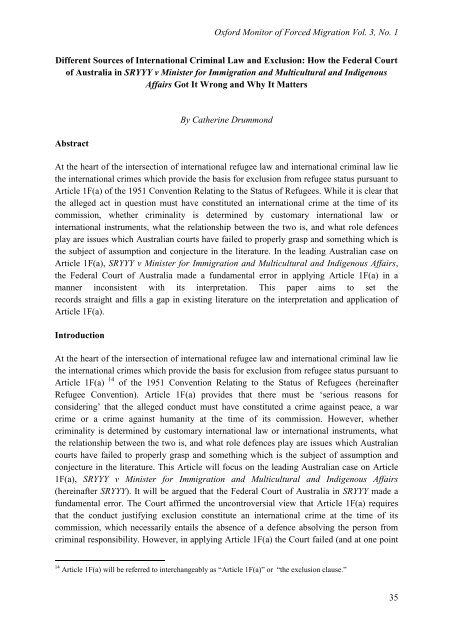OxMo-Vol.-3-No.-1
OxMo-Vol.-3-No.-1
OxMo-Vol.-3-No.-1
Create successful ePaper yourself
Turn your PDF publications into a flip-book with our unique Google optimized e-Paper software.
Oxford Monitor of Forced Migration <strong>Vol</strong>. 3, <strong>No</strong>. 1<br />
Different Sources of International Criminal Law and Exclusion: How the Federal Court<br />
of Australia in SRYYY v Minister for Immigration and Multicultural and Indigenous<br />
Affairs Got It Wrong and Why It Matters<br />
Abstract<br />
By Catherine Drummond<br />
At the heart of the intersection of international refugee law and international criminal law lie<br />
the international crimes which provide the basis for exclusion from refugee status pursuant to<br />
Article 1F(a) of the 1951 Convention Relating to the Status of Refugees. While it is clear that<br />
the alleged act in question must have constituted an international crime at the time of its<br />
commission, whether criminality is determined by customary international law or<br />
international instruments, what the relationship between the two is, and what role defences<br />
play are issues which Australian courts have failed to properly grasp and something which is<br />
the subject of assumption and conjecture in the literature. In the leading Australian case on<br />
Article 1F(a), SRYYY v Minister for Immigration and Multicultural and Indigenous Affairs,<br />
the Federal Court of Australia made a fundamental error in applying Article 1F(a) in a<br />
manner inconsistent with its interpretation. This paper aims to set the<br />
records straight and fills a gap in existing literature on the interpretation and application of<br />
Article 1F(a).<br />
Introduction<br />
At the heart of the intersection of international refugee law and international criminal law lie<br />
the international crimes which provide the basis for exclusion from refugee status pursuant to<br />
Article 1F(a) 14 of the 1951 Convention Relating to the Status of Refugees (hereinafter<br />
Refugee Convention). Article 1F(a) provides that there must be ‘serious reasons for<br />
considering’ that the alleged conduct must have constituted a crime against peace, a war<br />
crime or a crime against humanity at the time of its commission. However, whether<br />
criminality is determined by customary international law or international instruments, what<br />
the relationship between the two is, and what role defences play are issues which Australian<br />
courts have failed to properly grasp and something which is the subject of assumption and<br />
conjecture in the literature. This Article will focus on the leading Australian case on Article<br />
1F(a), SRYYY v Minister for Immigration and Multicultural and Indigenous Affairs<br />
(hereinafter SRYYY). It will be argued that the Federal Court of Australia in SRYYY made a<br />
fundamental error. The Court affirmed the uncontroversial view that Article 1F(a) requires<br />
that the conduct justifying exclusion constitute an international crime at the time of its<br />
commission, which necessarily entails the absence of a defence absolving the person from<br />
criminal responsibility. However, in applying Article 1F(a) the Court failed (and at one point<br />
14 Article 1F(a) will be referred to interchangeably as “Article 1F(a)” or “the exclusion clause.”<br />
35


